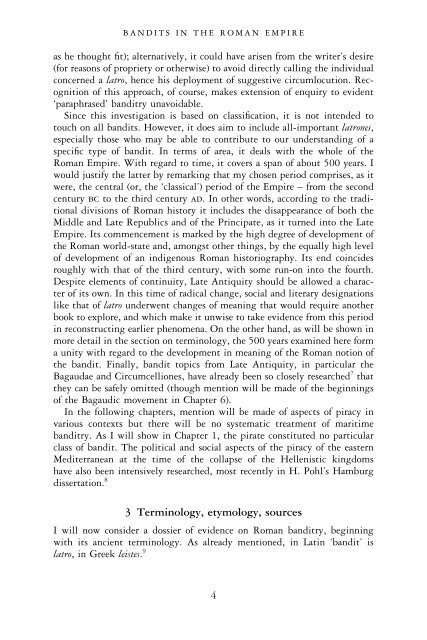You also want an ePaper? Increase the reach of your titles
YUMPU automatically turns print PDFs into web optimized ePapers that Google loves.
BANDITS IN THE ROMAN EMPIRE<br />
as he thought fit); alternatively, it could have arisen from the writer’s desire<br />
(for reasons of propriety or otherwise) to avoid directly calling the individual<br />
concerned a latro, hence his deployment of suggestive circumlocution. Recognition<br />
of this approach, of course, makes extension of enquiry to evident<br />
‘paraphrased’ banditry unavoidable.<br />
Since this investigation is based on classification, it is not intended to<br />
touch on all bandits. However, it does aim to include all-important <strong>latrones</strong>,<br />
especially those who may be able to contribute to our understanding of a<br />
specific type of bandit. In terms of area, it deals with the whole of the<br />
Roman Empire. With regard to time, it covers a span of about 500 years. I<br />
would justify the latter by remarking that my chosen period comprises, as it<br />
were, the central (or, the ‘classical’) period of the Empire – from the second<br />
century bc to the third century ad. In other words, according to the traditional<br />
divisions of Roman history it includes the disappearance of both the<br />
Middle and Late Republics and of the Principate, as it turned into the Late<br />
Empire. Its commencement is marked by the high degree of development of<br />
the Roman world-state and, amongst other things, by the equally high level<br />
of development of an indigenous Roman historiography. Its end coincides<br />
roughly with that of the third century, with some run-on into the fourth.<br />
Despite elements of continuity, Late Antiquity should be allowed a character<br />
of its own. In this time of radical change, social and literary designations<br />
like that of latro underwent changes of meaning that would require another<br />
book to explore, and which make it unwise to take evidence from this period<br />
in reconstructing earlier phenomena. On the other hand, as will be shown in<br />
more detail in the section on terminology, the 500 years examined here form<br />
a unity with regard to the development in meaning of the Roman notion of<br />
the bandit. Finally, bandit topics from Late Antiquity, in particular the<br />
Bagaudae and Circumcelliones, have already been so closely researched 7 that<br />
they can be safely omitted (though mention will be made of the beginnings<br />
of the Bagaudic movement in Chapter 6).<br />
In the following chapters, mention will be made of aspects of piracy in<br />
various contexts but there will be no systematic treatment of maritime<br />
banditry. As I will show in Chapter 1, the pirate constituted no particular<br />
class of bandit. The political and social aspects of the piracy of the eastern<br />
Mediterranean at the time of the collapse of the Hellenistic kingdoms<br />
have also been intensively researched, most recently in H. Pohl’s Hamburg<br />
dissertation. 8<br />
3 Terminology, etymology, sources<br />
I will now consider a dossier of evidence on Roman banditry, beginning<br />
with its ancient terminology. As already mentioned, in Latin ‘bandit’ is<br />
latro, in Greek leistes. 9<br />
4


